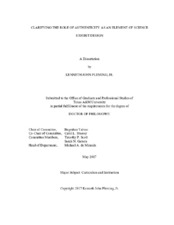| dc.contributor.advisor | Yalvac, Bugrahan | |
| dc.contributor.advisor | Stuessy, Carol L | |
| dc.creator | Fleming Jr., Kenneth John | |
| dc.date.accessioned | 2017-08-21T14:38:33Z | |
| dc.date.available | 2019-05-01T06:07:01Z | |
| dc.date.created | 2017-05 | |
| dc.date.issued | 2017-05-10 | |
| dc.date.submitted | May 2017 | |
| dc.identifier.uri | https://hdl.handle.net/1969.1/161462 | |
| dc.description.abstract | When the doors of a science center open, so do opportunities to step into oversized bubbles or unearth fossils in a dig site the size of a football field. Are those experiences educationally meaningful or merely novel? To address this question, I gathered evidence and interpretations in three separate yet connected studies on the design features of a quality science exhibit in three separate studies.
In the first study, I conducted a literature review on exhibit design features that had a moderating effect on learning. Each of the 19 studies in the sample was an empirical investigation. I used the findings from this review to (a) generate a research-based exhibit design resource and (b) highlight exhibit elements that need clarification.
In study two, I interviewed six veteran exhibit designers from nationally recognized institutions to clarify the role of authenticity in the exhibit design process. Findings from a constant comparative analysis of their interview data indicated that science exhibits needed to be authentic to the (a) institution, (b) learner, and (c) science as a field of study. “Scale” and “role-play” were two unique factors that shaped immersive environments in informal science education institutions.
My focus on the exhibit as a learning environment predicated the need to investigate how authenticity is expressed across a larger sample of exhibits. In the third study, I used four expressions of authenticity as pre-determined categories for a content analysis on 106 exhibit descriptions from summative evaluations in the Building Informal Science Education network database. The findings from this study affirmed the effect of an institution’s priorities on the presence of authentic artifacts (e.g., natural history museums) over hands-on experiences (e.g., science centers). Where visitors’ opportunities to interact with authentic artifacts might have been limited by the type of institution, visitors’ opportunities to explore with their senses were not. | en |
| dc.format.mimetype | application/pdf | |
| dc.language.iso | en | |
| dc.subject | Authenticity | en |
| dc.subject | Learning Environment | en |
| dc.subject | Exhibit Design | en |
| dc.title | Clarifying the Role of Authenticity as an Element in Science Exhibit Design | en |
| dc.type | Thesis | en |
| thesis.degree.department | Teaching, Learning, and Culture | en |
| thesis.degree.discipline | Curriculum and Instruction | en |
| thesis.degree.grantor | Texas A & M University | en |
| thesis.degree.name | Doctor of Philosophy | en |
| thesis.degree.level | Doctoral | en |
| dc.contributor.committeeMember | Scott, Timothy P | |
| dc.contributor.committeeMember | Gatson, Sarah N | |
| dc.type.material | text | en |
| dc.date.updated | 2017-08-21T14:38:33Z | |
| local.embargo.terms | 2019-05-01 | |
| local.etdauthor.orcid | 0000-0002-6728-5317 | |


